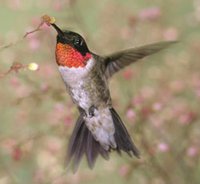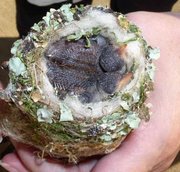Hummingbird
|
|
- For the Australian jangle pop band, see The Hummingbirds.
| Hummingbirds | ||||||||||
|---|---|---|---|---|---|---|---|---|---|---|
 Ruby-throated Hummingbird | ||||||||||
| Scientific classification | ||||||||||
| ||||||||||
| Genera | ||||||||||
|
Many, see text. |
Hummingbirds (family Trochilidae) are small birds capable of hovering in mid-air due to the rapid flapping of their wings (15 to 80 beats per second, depending on the size of the bird). They are named for the characteristic hum of this rapid wing motion. They are the only birds that can fly backwards.
Hummingbirds are attracted to many flowering plants—shrimp plants, fuchsias, many penstemons, etc.—especially those with red flowers. Hummingbirds feed on the nectar of these plants. They are important pollinators, especially of deep-throated flowers. Most species also eat insects.
Hummingbirds bear the most glittering plumage and some of the most elegant adornments. Male hummingbirds are usually brightly coloured, females duller. The males take no part in nesting. The nest is usually a neat cup in a tree. Two white eggs are laid, which are quite small, but large relative to the bird's size. Incubation is typically 14-19 days.
The Bee Hummingbird (Mellisuga helenae) is, at 1.8 grams, the smallest bird in the world. A typical North American hummingbird, the Ruby-throated Hummingbird (Archilochus colubris) weighs approximately 3 grams and has a length of 7.6 cm (3 in).
| Contents |
Colours and Adornments
The names that admiring naturalists have given to hummingbirds suggest exquisite, fairylike grace and gemlike refulgence. Fiery-tailed Awlbill, Ruby-topaz Hummingbird, Glittering-bellied Emerald, Brazilian Ruby, Green-crowned Brilliant--are some of the names applied to the 233 species of the hummingbirds briefly described in Rodolphe Meyer de Schauensee's scientific Guide to Birds of South America.
Metabolism
Hummingbirds have the highest metabolism of all animals except insects in flight, a necessity in order to support the rapid beating of their wings. Their heartbeat can reach 500 beats per minute. They also typically consume more than their own weight in food each day, and to do that, they have to visit hundreds of flowers every day. But at any given moment, they're hours away from starving. Fortunately, they are capable of slowing down their metabolism at night, or any other time food is not readily available. They enter a hibernation-like state known as torpor. During torpor, the heartrate and rate of breathing are both slowed dramatically, reducing their need for food.
Studies of hummingbirds' metabolism are highly relevant to the question of whether a migrating ruby-throated hummingbird can cross 500 miles of Gulf of Mexico on a nonstop flight, as field observations suggest it does. The ruby-throated hummingbird like other birds preparing to migrate, stores up fat to serve as fuel, thereby augmenting its weight by as much as 40 to 50 per cent--this would increase the bird's flying time. (Skutch, 1973)
Location
Hummingbirds are only found in the Americas, from southern Canada and Alaska to Tierra del Fuego, including the West Indies. The Black-chinned Hummingbird is the most common species in the western United States and Canada. Only the Ruby-throated Hummingbird breeds in eastern North America, but occasional members of other hummingbird species ("accidentals" in birding jargon) are seen in the east of North America, sometimes as vagrants from Cuba or the Bahamas.
Hummingbirds of the U.S. and Canada generally migrate to warmer climates, though some remain in the warmest coastal regions. In addition, there is an increasing trend for Rufous Hummingbirds to migrate east to winter in the eastern United States, rather than south to Central America, this trend being the result of increased survival with the provision of artificial feeders in gardens. In the past, individuals that migrated east would usually die, but now they survive, and their tendency to migrate east is inherited by their offspring. Provided sufficient food and shelter is available, they are surprisingly hardy, able to tolerate temperatures down to at least -20°C.
Hummingbirds owe their wide distribution to their great power of flight and wandering habits no less than to their hardiness.
Hummingbirds and People
Feeding
Lightmatter_hummingbird.jpg
Hummingbirds will use feeders, particularly red ones. A suitable artificial nectar consists of one part sugar to four parts water. It is easiest to dissolve the sugar in boiling water, then cool it completely before putting it out for the birds. Sweet foods other than white sugar, such as honey, ferment too quickly and can injure the birds. Some commercial hummingbird foods are available, but they contain red dyes which are unnecessary and have been anecdotally reported to poison the birds. They also contain small amounts of nutrients, but hummingbirds apparently get their nutrients from the insects they eat, not from nectar, so the nutrients are also unnecessary. Thus plain white sugar and water make the best nectar.
The feeder should be rinsed and the water changed weekly, or more often in warm weather. At least once a month, or whenever black mold appears, it should be soaked in a solution of chlorine bleach. Hummingbirds tend to avoid feeders that have been cleaned with soap, possibly because they dislike the smell.
Much more detailed information is available at [1] (http://www.hummingbirds.net/).
Trapped Hummingbirds
Hummingbirds sometimes fly into garages and become trapped. It is widely believed that this is because they mistake the hanging (usually red-colored) door-release handle for a flower, although hummingbirds can also get trapped in enclosures that do not contain anything red. Once inside, they may be unable to escape because their natural instinct when threatened or trapped is to fly upward. This is a life-threatening situation for hummingbirds, as they can become exhausted and die in a relatively short period of time, possibly as little as an hour. If a trapped hummingbird is within reach, it can often be caught gently and released outdoors. It will lie quietly in the space between cupped hands until released.
In Artistic Depiction
The Aztec god Huitzilopochtli is often depicted as a hummingbird.
In Story
The Ohlone tells the story[2] (http://www.npca.org/cultural_diversity/native_expression/hummingbird.asp) of how a Hummingbird brought fire to the world.
Taxonomy
Traditionally hummingbirds were placed in the order Apodiformes, which also contains the swifts. In the modern Sibley-Ahlquist taxonomy, hummingbirds are separated as a new hummingbird order Trochiliformes.
There are between 325 and 340 species of hummingbird, depending on taxonomic viewpoint, divided into two subfamilies, the hermits (subfamily Phaethornithinae, 34 species in six genera), and the typical hummingbirds (subfamily Trochilinae, all the others).
Hummingbirds have been thought by evolutionists to have evolved in South America, and the great majority of the species are found there. All the most familiar North American species are thought to be of relatively recent origin, and are therefore (following the usual procedure of lists starting with more 'ancestral' species and ending with the most recent) listed close to the end of the list.
Genetic analysis has indicated that hummingbirds diverged from other birds 30 to 40 million years ago, but fossil evidence has proved elusive. Fossil hummingbirds have been found as old as a million years, but older fossils had not been securely identifiable as hummingbirds. Then, in 2004, Dr. Gerald Mayr of the Senkenberg Natural History Museum in Frankfurt-am-Main identified two 30-million-year old German hummingbird fossils and published his results in Nature. The fossils of the extinct hummingbird species, Eurotrochilus inexpectatus ("unexpected European hummingbird") had been sitting in a museum drawer in Stuttgart. They had been unearthed in a claypit in Frauenweiler, south of Heidelberg.
See also
External links
- Hummingbird Society's Photo Gallery (http://www.hummingbirdsociety.org/photogallery/)
- Hummingbirds and their family (http://www.birdonline.org/hummingbird/hummingbird.htm)
- hummingbirds.net (http://www.hummingbirds.net/)
- The Hummingbird Web Site (http://www.portalproductions.com/h/index.html)
- Hummingbirds of the World (http://www.camacdonald.com/birding/Sampler3-Hummingbirds.html)
- Hummingbirds (http://www.infochembio.ethz.ch/links/en/zool_voegel_kolibris.html)
References
- Alexander F. Skutch and Arthur B. Singer, The Life of the Hummingbird, New York, Vineyard, ISBN 0-517-20272X
de:Kolibri es:Colibrí fr:Trochilidae it:Colibrì lt:Kolibriniai nl:Kolibries ja:ハチドリ pt:Beija-flor sl:kolibri zh:蜂鸟


